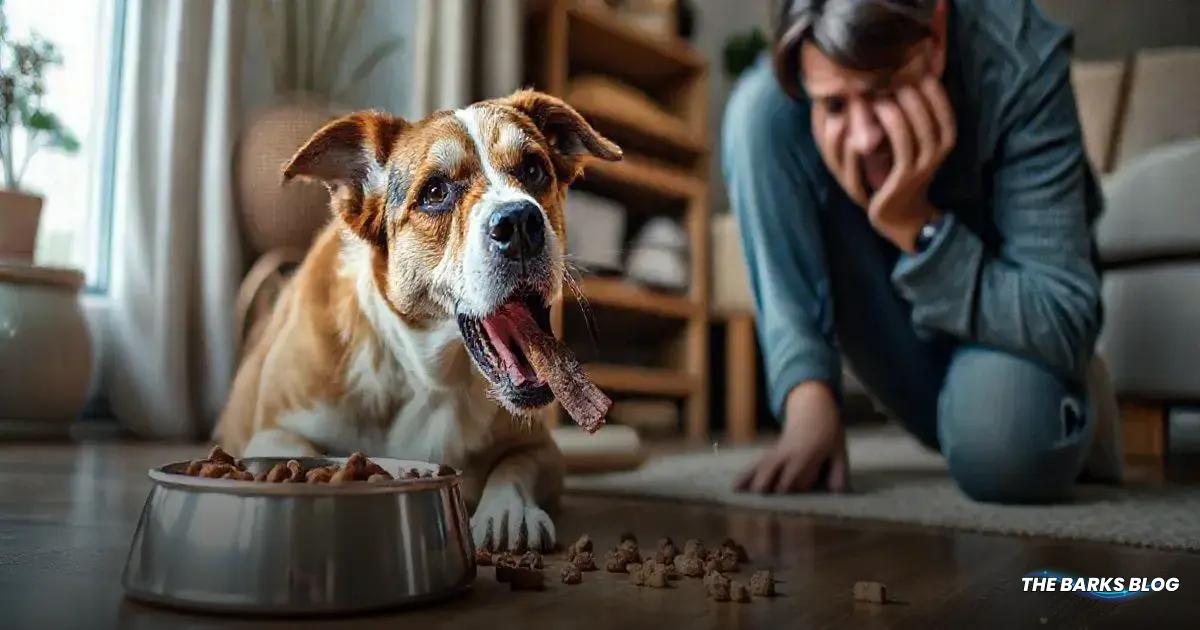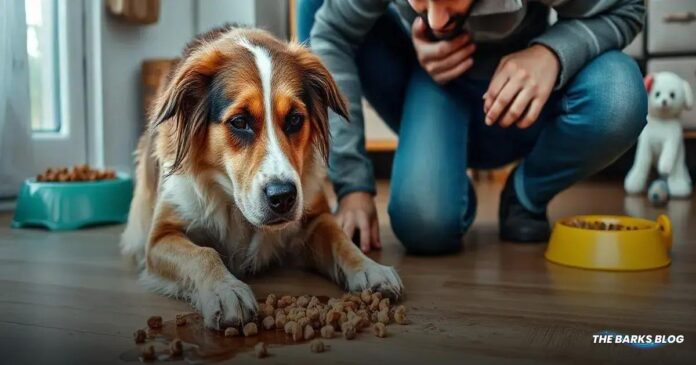Understanding dog vomiting is important for pet owners, as it can result from various factors like eating too fast, overeating, food sensitivities, or gastrointestinal issues. It’s crucial to differentiate between regurgitation, which is passive and occurs soon after eating, and vomiting, which is active and can happen later. To prevent vomiting, owners can use slow feeder bowls, space out meals, and create a calm eating environment. If vomiting continues or is accompanied by other symptoms, consulting a veterinarian is essential for proper care.
When it comes to dog vomiting, there are all sorts of varieties that concern pet parents. And when a dog is throwing up undigested food, it may cause pet owners to worry that their pups aren’t getting adequate nutrition and that something is wrong.

The Basics of Dog Digestion
To understand why your dog might be throwing up undigested food, it’s essential to know a bit about dog digestion. A dog’s digestive process begins in the mouth, where food is broken down by chewing and saliva. This initial step is crucial as it prepares the food for further digestion.
Once swallowed, the food travels down the esophagus and into the stomach, where it mixes with gastric juices. This process typically takes about 6 to 8 hours, but can vary depending on the type of food. For instance, kibble might take longer to digest than wet or fresh food.
Understanding this process can help you identify potential issues. If your dog is throwing up undigested food, it may indicate that the food is not being processed correctly in the stomach or that there are other underlying health concerns affecting digestion.

Dog Regurgitation Vs. Dog Vomiting
Understanding the difference between dog regurgitation and dog vomiting can help you determine the severity of your dog’s issue.
Regurgitation is a passive process where undigested food is expelled from the esophagus, usually without any warning signs. It often occurs shortly after eating and can be characterized by the food being tubular in shape and appearing undigested.
On the other hand, vomiting is an active process where the stomach contents are forcefully expelled. Vomiting is often accompanied by retching, drooling, and abdominal contractions, making it more distressing for your dog. This can happen hours after eating, and the food may be partially digested and mixed with bile.
While regurgitation is generally less serious than vomiting, it can still indicate an underlying issue, such as esophageal problems. Recognizing these differences is crucial for pet parents to assess their dog’s health and determine when to seek veterinary care.

Signs of Regurgitation in Dogs
Signs of Regurgitation in Dogs
Regurgitation in dogs can be identified by several key signs:
- Occurs shortly after eating
- Food is undigested and often tubular in shape
- No prior signs of distress
Recognizing these signs can help you determine if your dog is experiencing regurgitation rather than vomiting. If you notice these symptoms, it’s essential to monitor your dog closely and consult with a veterinarian if regurgitation occurs frequently or is accompanied by other concerning signs.

Tips for Preventing Dogs From Vomiting Undigested Food
Tips for Preventing Dogs From Vomiting Undigested Food
After you’ve determined that your dog’s vomiting isn’t due to a potentially serious medical condition, there are some simple steps you can take at home to reduce the chance that your dog will vomit undigested food:
- Space out meals: Feeding smaller, more frequent meals can help prevent overeating and reduce the likelihood of vomiting.
- Use a slow feeder bowl: These bowls are designed to slow down eating, allowing your dog to chew their food properly and prevent gulping.
- Switch food slowly: Gradually transition to new food over the course of a week to avoid upsetting your dog’s stomach.
- Avoid table scraps: Stick to a consistent diet to avoid digestive upset and keep your dog’s stomach healthy.
- Maintain a calm environment: Reducing stress and anxiety can help prevent vomiting related to nervousness or anxiety in dogs.
By understanding the causes and taking preventive measures, you can help ensure your dog’s digestive health and reduce the chances of them throwing up undigested food. If the problem persists, always consult your veterinarian for professional advice.
Conclusion
In summary, while it can be concerning to see your dog throwing up undigested food, understanding the differences between regurgitation and vomiting is crucial for determining the right course of action.
By recognizing the signs and causes, you can take effective steps to prevent this issue. Implementing strategies like spacing out meals, using slow feeder bowls, and maintaining a calm environment can significantly improve your dog’s digestive health.
If vomiting persists or is accompanied by other symptoms, it’s essential to seek veterinary advice to rule out any serious health problems. Keeping a close eye on your dog’s eating habits and overall behavior will help you ensure their well-being and happiness.
FAQ – Frequently Asked Questions about Dog Vomiting
What is the difference between dog vomiting and regurgitation?
Dog vomiting is an active process where the stomach contents are forcefully expelled, often with retching and abdominal contractions. Regurgitation is passive, where undigested food is expelled from the esophagus without warning.
What should I do if my dog vomits undigested food?
If your dog vomits undigested food occasionally and shows no other signs of illness, it may not be a cause for concern. However, if it happens frequently or is accompanied by other symptoms, consult your veterinarian.
What are some common causes of dogs throwing up undigested food?
Common causes include eating too fast, overeating, food sensitivities, anxiety, and gastrointestinal disorders.
How can I prevent my dog from vomiting undigested food?
You can prevent this by spacing out meals, using slow feeder bowls, gradually transitioning to new food, avoiding table scraps, and maintaining a calm environment.
When should I be concerned about my dog’s vomiting?
If your dog vomits frequently, has other signs of illness (like lethargy or diarrhea), or vomits hours after eating, you should seek veterinary care.
Can puppies vomit undigested food more than adult dogs?
Yes, puppies have more sensitive digestive systems and may vomit undigested food more often due to their smaller stomachs and rapid growth.




